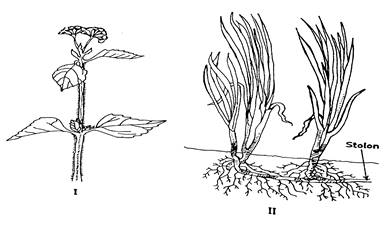Question 3
The diagrams below illustrate unwanted plants found growing on a farmland. Study them and answer the question that follow.

(a) Give the botanical name of each plant. (2 marks)
(b) Name one method of seed dispersal of each plant. (2 marks)
(c) Give three reasons why the plant illustrated in diagram II is difficult to eradicate on the
farm. (3 marks)
(d) Mention five ways in which the plant labelled I is of economic importance in agriculture.
(5 marks)
(e) State three physical methods by which a farmer could control the growth of the plants on a farmland. (3 marks)
Observation
- Many candidates could not write the botanical names of goat weed and spear grass correctly. Some candidates did not follow the scientific convention in writing botanical names i.e. underlining the generic and species name, starting the generic name with a capital letter and the species name with a small letter etc.
- Although most candidates were able to name the method of seed dispersal of goat weed and spear grass, very few could give reasons why spear grass is difficult to eradicate on the farm. Furthermore, few candidates understood the economic importance of goat weed in agriculture.
The expected answers include:
3. . . (a) Botanical names of weeds
I - Ageratum conyzoides
II - Imperata cylindrica
(b) Methods of dispersal of weeds
I (Ageratum conyzoides)
- Wind
- Water
- Animals
II (Imperata cylindrica)
- Wind
(c) Reasons why II (Imperata cylindrica) is difficult to eradicate on the farm
- Has the ability to produce both roots and new shoots from each node
- It is buried underground, making it difficult to uproot/has underground stem
- Resistant to drought/survive in dry areas
- Resistant to burning
- Has stolons which produce new shoots after cutting
- It can withstand trampling
(d) Ways in which I (Ageratum conyzoides) is of economic importance in agriculture
- Compete with crops for nutrients
- Compete with crops for sunlight
- Compete with crops for space
- Harbour pests
- Harbour diseases
- Compete with crops for soil moisture/water
- Reduces the yield of crops
- Increases the cost of production
- Some weeds are toxic to farm animals
- Serves as insecticide and nematicide in soil
- Reduces the quality of farm produce
- It is used by farmers for medicinal purpose e.g. treatment of dysentery
(e) Physical methods by which a farmer could control the growth of the weeds
- Slashing/mowing
- Hand pulling/rogueing/uprooting
- Hoeing
- Ploughing
